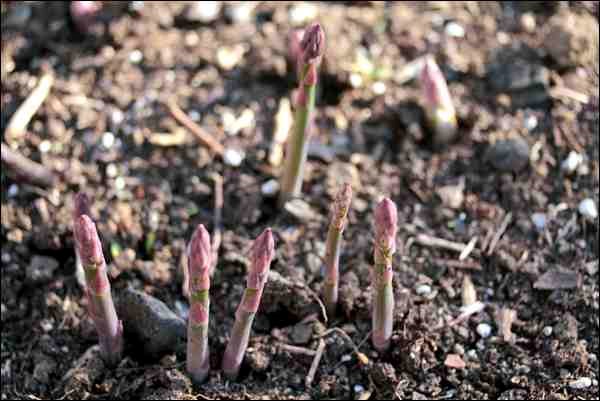Avid vegetable gardeners go through a series of rituals every spring, the most important of which is selecting and purchasing new vegetable seeds. Asparagus, a long-lived perennial vegetable, is an exception to that ritual.
Asparagus (Asparagus officinalis) is native to most of Europe, northern Africa and western Asia. It grows best in cooler climates with warm summers and cold winters.
You can start asparagus from seed directly in ground, but it's best to start them indoors in February. But since we're well past that, check out your local garden centre now for asparagus transplants or year-old crowns.
Because asparagus is perennial, it is very important to prepare the soil with care and attention. If possible, choose a well-drained area with loam to sandy-loam soil as asparagus planted into poorly drained soil is prone to disease. Prior to planting, add a layer of well-rotted manure (at least 5 cm/2 in. deep). Incorporate the manure into the soil and ensure the area to be planted is well worked. Weed control is essential during the first years.
Asparagus seeds, transplants and crowns should be planted in spring or early summer. Planting can occur as soon as the ground has thawed and the soil is easily worked. Dig a trench at least 20 cm (8 in.) deep. Plant seeds, crowns or transplants in the trench, covering them with 5 cm (2 in.) of soil. As the season progresses, fill in the furrow a little every few weeks, covering part of the plant but never burying it. By the end of the growing season, the trench should be level with the surrounding soil.
Space plants 30 cm (12 in.) within-the-row and 2m (6 ft.) between rows. After planting roots or transplants, water them in with 10-52-10 fertilizer mixed according to label directions. This fertilizer is high in phosphorous and encourages root growth.
While the new transplants or seedlings need moisture for good growth, it is important not to overwater a new asparagus patch. It is best to water deeply but less frequently, allowing at least the top 2.5cm of soil to dry thoroughly before re-watering.
Patience is said to be a virtue and with new asparagus plantings, that old saw applies in spades when it comes to waiting for the first harvest: do not harvest for the first two years. During the third year, you can harvest for two weeks. Starting with the fourth year, you can harvest for the full 4 to 6 week period, until the end of June.
Spears can be cut when they are about 15 cm (6 in.) tall. Cut the spear 2.5 cm (1 in.) below ground, taking care to avoid damaging new shoots yet to emerge. In a productive patch, you could be harvesting as often as every other day.
After July 1 through to frost, top growth (1 - 1.5 m tall ferns) must be allowed to rebuild crown energy reserves that have been drawn down from the harvest. Harvesting past July 1 weakens plants and leads to reduced harvest in the following year.
Ferns can be left standing over winter to trap snow. Since the crown is covered with several inches of soil, mulching is usually not required. But if in an open area, a 20 cm (4 in.) mulch layer will reduce winterkill.
'Guelph Millennium' is a male hybrid with good yield, excellent flavour and disease resistance. It was developed in Canada and is dependably hardy on the prairies. Two other cultivars that I'd recommend are 'Jersey Knight' and 'Jersey Supreme'; both are male hybrids with good yield.
Bantle is a horticulturist who gardens in Saskatoon.
Have a gardening question? Contact GardenLine, 306-966-5865 or [email protected].
This column is provided courtesy of the Saskatchewan Perennial Society (www.saskperennial.ca; [email protected]). Check out our Bulletin Board or Calendar for upcoming horticulture events in May.




